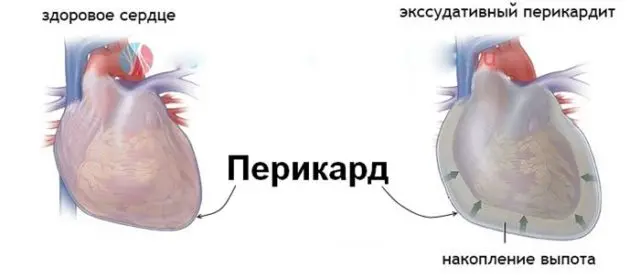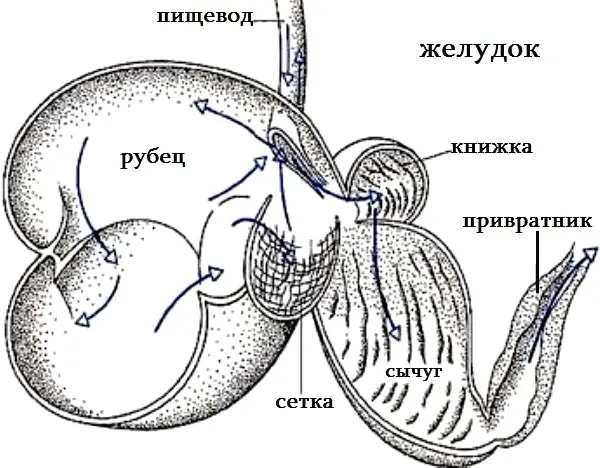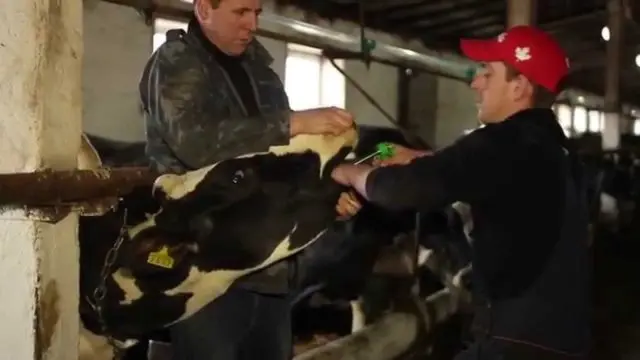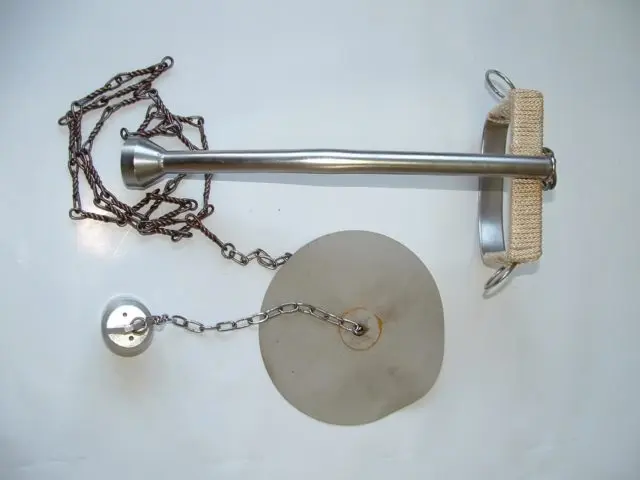Contents
Traumatic pericarditis in cows is observed due to the penetration of sharp objects into the chest cavity of the animal from the outside and from the inside, from the side of the esophagus and mesh. Needles, knitting needles, pins, wire can become dangerous. There are also cases of pericarditis in cows with heart injuries due to fracture of the ribs, injury to the chest cavity.
What is traumatic pericarditis
The pericardium is a cavity that surrounds the heart. It is designed to protect the body from inflammation and various infections.
Traumatic pericarditis is a complex inflammatory process of the pericardial sac and nearby tissues, visceral and parenteral pericardial layer. Occurs when injured by foreign objects that can get into the cow’s net with feed. The sharp parts of the objects pierce the wall of the animal’s stomach and move closer to the heart. In this case, the lungs and liver may suffer, but more often the object injures the heart, since blood moves to it. At the same time, pathogenic microflora penetrates into the wound, causing inflammation in the tissues. Developing, the disease disrupts the morphological and functional state of many organs and tissues.

Contracting, the stomach pushes the object farther and farther. Thus, the myocardium and epicardium (middle and outer heart membrane) can be injured. In the course of movement of a foreign body, the vessels and capillaries are injured, an accumulation of blood forms between the heart and the bag, which increases pressure on the heart muscle. This causes it to stop.
In addition, as a result of inflammation and irritation, hemorrhage, edema, cell exfoliation, and fibrin loss occur. In the future, the pericardial cavity is filled with exudate, which also complicates the work of the heart. The amount of discharge can reach up to 30-40 liters.
The liquid is:
- serous;
- purulent;
- serous-fibrous;
- hemorrhagic.
Slowing of the blood flow through the veins, squeezing the lungs causes rapid breathing. The inflammatory process leads to irritation of the nerve endings, which provokes pain in the cow, malfunctions of the heart and breathing, along with this, the functions of the preventricles weaken. Toxins and exudate released into the bloodstream, increases the body temperature of the animal.
In addition to the causes of traumatic pericarditis, it should be noted that some other factors influence the development of this disease. The main ones are an increase in pressure on the peritoneum. This can help:
- childbirth;
- the fall of a cow on its stomach, chest to the ground;
- blow to the abdominal region;
- increased appetite, which leads to excessive filling of the cow’s ventricles.
Often a factor provoking the development of traumatic pericarditis is a strong physical overstrain of the animal.
Signs of traumatic pericarditis in animals
As a rule, traumatic pericarditis occurs in several forms: acute, subacute, and often becomes chronic. Also, this disease is characterized by a dry and effusion phase. The dry phase begins from the moment the cow is injured and continues until fluid appears in the inflamed areas.

In acute traumatic pericarditis in the dry phase, cows develop soreness. She avoids sudden movements, can moan, arches her back, stands with her limbs wide apart. During this period of the development of the disease, the cow has a rapid heartbeat, contractions of the heart muscle appear, during which a noise is heard during listening, reminiscent of friction.
Further, the dry phase of traumatic pericarditis passes into the effusion stage of the disease. The previously heard friction changes to splashing, which indicates the presence of liquid. The heartbeat increases, and the pain, on the contrary, decreases, since the layers of the pericardium are separated by fluid and the inflamed areas do not come into contact with each other.
When pathogenic microorganisms penetrate into the bag along with a foreign object, serous-fibrous inflammation develops, turning into purulent-putrefactive with the appearance of gases. This stage is characterized by the deformation of the shirt, the filling of a cloudy exudate, which contains purulent-fibrous masses with a putrid odor.
As exudate accumulates, the pressure on the cow’s heart increases and it cannot expand to normal volumes. This leads to circulatory problems
This is followed by:
- the appearance of shortness of breath in the animal;
- the liver increases in volume;
- noticeable constant tachycardia;
- reduced pressure;
- bronchitis develops;
- bluish mucous membranes of the animal.
Together with these symptoms, the cow has no appetite, there is a disorder of the cud, tympania (swelling of the scar), milk yield drops sharply, body temperature rises.
At autopsy of cows that died from traumatic pericarditis, exudate is noted in different amounts (30-40 l). With dry pericarditis, the fluid is fibrous, with the effusion phase – serous, serous-fibrous, hemorrhagic, purulent.

In the serous form of the disease, the integument of the heart is hyperemic, small hemorrhages are visible. In traumatic fibrous pericarditis, there are traces of yellowish fibrous masses on the sheets of the pericardium. For purulent pericarditis, accumulations of turbid fluid are characteristic. At the same time, the sheets of the pericardium are edematous, red, with small hemorrhages with abscesses. Hemorrhagic pericarditis is marked by accumulation of hemorrhagic fluid in the pericardium. The epicardium and pericardium are edematous, dull in color with petechial hemorrhages.
In the course of movement of a foreign body, fibrous bands, abscesses, fistulas with purulent contents are visible. Sometimes you can find a certain strand between the shirt, the diaphragm and the mesh. Often at the puncture site, you can find the foreign object itself, which caused the inflammatory process. It is found in the pericardium or in the myocardium. In some cases, a foreign object is not found at autopsy.
Diagnosis of traumatic pericarditis in cattle
The diagnosis of acute traumatic pericarditis is established by a veterinarian on the basis of pain and noise when listening to the cardiac region, increased heart beat, and tachycardia. The effusion phase of pericarditis is characterized by a shift and some weakening of the cardiac impulse, and with percussion, deafness of tones, splashing, overflow of the jugular veins, and significant swelling are heard. X-ray determines the increase and immobility of the cow’s heart, the fuzziness of the diaphragmatic triangle. In difficult situations, the veterinarian performs a needle puncture, which is used for novocaine blockades. The puncture is made on the left, in the middle of the level of the elbow and shoulder joint of the cow, in the fourth intercostal space.
For the correct diagnosis, the veterinarian should exclude dropsy of the shirt, exudative pleurisy. Dry pericarditis and the initial stage of effusion pericarditis should be distinguished from pleurisy and acute myocarditis and endocarditis. An experienced specialist knows that dropsy proceeds without pain in the heart and fever. With pleurisy, friction noises may coincide with breathing during auscultation.

Treatment of traumatic bovine pericarditis
Conservative treatment of traumatic pericarditis in cows, as a rule, does not bring the desired effect, more often animals are sent for slaughter. However, sometimes attempts to treat a cow bring positive results.
As a first aid, the animal must be provided with peace, transferred to a separate stall. To prevent the development of the inflammatory process, you need to apply ice to the area of uXNUMXbuXNUMXbthe heart. All large feeds are removed from the diet, replacing them with fresh grass, hay, liquid mixtures with bran. If the cow refuses food, artificial feeding can be prescribed.
Further medical measures should be as follows:
- restoration of heart functions;
- elimination of inflammatory processes;
- removal of fluid from the pericardial cavity.
After fixing the ice bag, glucose solution is administered intravenously.
After carrying out all the necessary therapeutic actions that did not bring a positive result, the cow is sent for slaughter. Sometimes they resort to surgical intervention to remove a foreign object from the animal’s body.
Prognosis and prevention
The prognosis for traumatic pericarditis in cows is usually poor. Most often, animals are culled from the herd. Pericarditis caused by injuries of the thoracic region, for example, stab wounds, broken ribs, responds well to treatment.

Preventive measures of traumatic pericarditis are to prevent foreign objects from entering the feed and to ensure safe conditions for keeping cows on the farm. The main preventive measures are to fulfill the following conditions:
- Hay packages should be unpacked in a specially designated place to prevent wire fragments from getting into cows’ food.
- If the chain is damaged, it must be replaced with a new one.
- Loose feed should be carefully checked for metal objects before being fed to cows. There is an electromagnetic device for this.
- In case of frequent cases of traumatic pericarditis in the herd, all cows should be checked with a special probe. This will allow timely removal of a foreign object from the digestive organs of the cow.
- Vitamins and trace elements must be added to feed. This will prevent cows from wanting to swallow foreign objects. With their lack, a metabolic disorder develops and the cow begins to “lizuha” – she constantly licks the walls, the ground, swallowing foreign objects.
- Do not let a cow walk near roads or in the area of dumps and construction sites.
Conclusion
Traumatic pericarditis in cows significantly reduces productivity, often leading to death of cattle. Such a disease does not respond well to conservative treatment, so it is important to take preventive measures in a timely manner. They will reduce the risk of traumatic pericarditis in animals.









